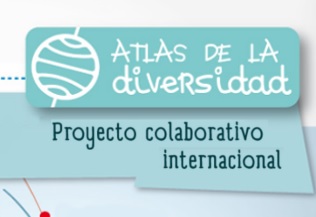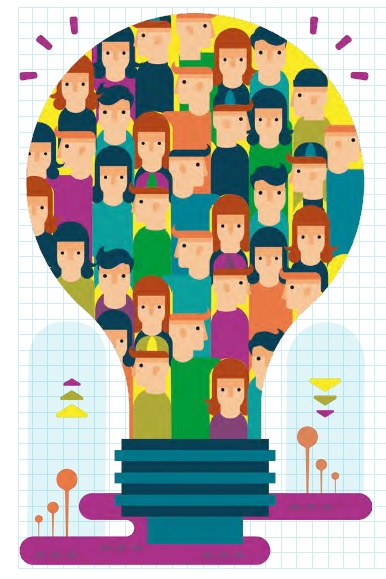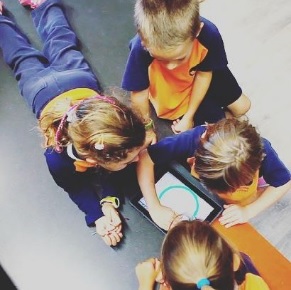The connection between schools is via networks or face-to-face meetings, in order to share knowledge between:
– Teams of teachers on their classroom practices.
– Groups of teachers to transfer peer-to-peer training.
– Classrooms for teachers and students to design, carry out and evaluate cooperative projects.
To discover the keys to collaborative and networked learning between teachers and schools, we follow in the footsteps of two of the leading specialists in this “art”, Paula Pérez and Narcís Vives, and we pay attention to the ideology they put forward in their book and project: “Atlas of Cultural Diversity.” Because, as they argue, “networks don’t work because of technology, but because of people who, in a committed and supportive way, sustain them.”
How to organise a networked collaborative project?
In order to address the organisational issue in this type of project, it is recommended to take care of the design of two major dimensions:
– The formation of the consortium or management team.
– The formation of working teams.
The configuration of the consortium must comply with two key premises:
1. Think of a project that the management team “knows how to do”, so that they are able to propose ideas for improvement that will enhance the quality and scalability of the project already underway.
2. Doing so with people and institutions, most of whom you know and with whom you share the work of many years.
Creating and consolidating the network: how to create working teams and networks of people
When thinking about a project, one also thinks about setting up a working team that can carry it out successfully. This aspect is key and belongs to the origin of the project and not, as it is often thought, to a later stage. Imagining the project and who can implement it from the beginning facilitates processes, saves time and efforts.
A work team is formed to achieve a common goal, knowing that the result of that work will be significantly better than what could be achieved by working individually.
Assumes:
– the knowledge and adherence of its members to the objectives of the project, – the interaction and constant work among them, which usually takes place for a determined period of time, previously established.
The make-up of these teams will vary according to the objectives and focus of each team. For the development of a project, small teams can be created to focus on a certain aspect; some will interact with each other, but all will inevitably have to interact with the project management, an indispensable component in the life of any project.
The management has the difficult task of ensuring that all team members “see” the same horizon in the project, beyond the different visions and perspectives -which certainly enrich it-; it must guide, motivate and closely monitor the teams formed.
Management styles have evolved over time and today are identified with what is called leadership. Although there are different styles of leadership, we are not going to go into this topic in depth, as it has already been extensively developed in a large number of specialised bibliographies. However, we do want to mention that leadership we believe is appropriate for this type of collaborative and networked learning projects: “shared leadership”.
Shared leadership involves strengthening people at all levels, encouraging their initiatives and giving them the opportunity to make decisions. While there is not yet much certainty about how it operates, it is clear that this type of leadership is the model of the future and, in any case, the one we consider appropriate for this type of project. Why? Because a flatter, more decentralised structure is a typical feature of networking. Networks promote distributed, autonomous and participatory leadership at all levels. Networks cultivate formal and informal leadership within communities to develop people capable of leading the network at every level (Fundación Evolución, REDAL, 2006).
Networking is not a novelty. “Networks existed before the Internet, the Web and other ICT achievements. What changes is the scope, speed, complexity and depth of new networks interactions. What remains the same is that it takes not only tools, but the will. And this willingness is born – if partly from the very possibility of doing so given by ICTs themselves – from the interest, the need and the belief that it is not only better to share information and work together, but the only effective way in the new time” (Prince, 2005).
And no one said that networking was an easy job. It requires a dynamic coordination that brings together all this autonomous and distributed work, giving it coherence and unity.
Collaborative Telematics Projects
Collaborative telematics projects represent a great potential for creating human networks and fostering information and experiences exchange. Telematics refers to projects that use information and communication technologies to support work, exchange and communication.
Judi Harris (researcher of the TPACK method) groups educational telematics projects into three broad categories:
- Projects focused on personal exchanges,

- Projects focused on information gathering and,
- Projects focused on collaborative problem solving.
Projects focused on personal exchanges are those where the main motivation is communication between users.
Projects focused on information gathering have as their main objective the search for information on a topic, with all the transversal learning that this implies (hypotheses, documentation, organisation of information, drawing up and publishing conclusions, etc.).
Projects focused on collaborative problem solving seek to enrich the project through the implementation of cooperation between working teams. The collaborative characteristic implies the possibility of co-constructing understanding through the comparison and combination of alternative ideas, interpretations and representations among participants in an intra-school and inter-school manner.
When we talk about an intra-school project, the participants are from the same environment (school, institution, etc.) and usually share the same culture. This type of project is assessed face-to-face and the role of the tutor is generally assumed by an educator from a specific area who knows the participants.
When we refer to an inter-school project, the participants are from different backgrounds. The project promotes intercultural exchange, the evaluation of the project can take place both online and face-to-face and the role of the tutor can be assumed by any educator – who does not necessarily know all the participants.
“Participating in a collaborative project involves interdisciplinary work, while project-based work involves a different organisation of school contents. In general, it is not from a subject and its specific curricular contents that the task is organised, but the project provides the context from which the need for disciplines and an organisation according to the project emerges” (López, 2006)
Telematic animation. How to keep a project alive
When we talk about animation, we are referring to the set of actions aimed at promoting the participation of people in a specific activity and, especially, in the socio-cultural development of the group of which they take part.
To animate means to infuse energy, to give things movement. And therefore in the development of a project it means: encouraging, mobilising, and promoting the participation of all members. It is, in short, an indispensable means of promoting networking and keeping it alive. The telematics animation almost instantly brings us back to a distance learning course and the role that tutors play in it.
But telematics animation is not only necessary when we talk about a course. It must be present at all project levels: the general management and coordination, the different work teams, the network of institutions leading the project, the network of tutors, and the network of participants.
Revitalising a project requires a great deal of daily dedication and follow-up. Laying the foundations, setting it in motion and keeping it alive over time does not happen spontaneously. A lot of work needs to be done to achieve this.
And animation is a key aspect. This is what helps “to keep going, not to let our guard down, always to keep going…”
When gathering the team of animators, it is important to take into account not so much their technological performance – which can always be acquired – but the personalised follow-up they can provide for their group and the support they can offer, as we understand that their role is not limited to answering queries. Its main goal is to make the Project’s virtual space a pleasant place for learning and exchange, where the participation of everyone is essential in order to form a true community.
Participants’ realities – at all levels – are very varied. Experience has shown that an encouraging message, encouragement, guidance, reminders or recommendations are always welcome. And everyone should do so…
Networked learning environments
In order to facilitate our students’ learning, it is very important to be able to have a motivating workspace. One that stimulates curiosity, captures the learner’s attention and provides a common thread to sustain interest and move the learner on:
- Ask questions
- Work in groups
- Search for information
- Gradually resolve the didactic proposals that encourage their reflection and promote their learning.
Excellent learning environments can be found on the Internet. These websites have been specifically prepared to provide interesting information in a very attractive way, combining different multimedia elements, interactive and networked games and spaces for shared creation.
In these spaces, it is desirable that:
- Students can explore by designing and building
- Mistakes are allowed
- Set objectives rather than content
- Available access to experts
- The student is motivated to think.
The aim is for students to begin acquiring planning skills, procedures and methodologies that they did not have before they started, rather than learning how to build a particular object.
With the boom and massive implementation of blogs and the technologies associated with web 2.0, the possibility of creating networked learning environments has become even more attractive, as it allows for the incorporation of interactive elements that can play a fundamental role in the art of learning: didactics.
Competence-based learning: 2 inspirations + 1 video
New pedagogies: global learning in the classroom, an opportunity for the school of the 21st Century
Global education is one of the indispensable learning areas in the acquisition of 21st century competences. Recognising that teachers are the most strategic resource in educating students to be global citizens, different educational organisations and movements such as the US teacher training programme Teachers for Global Classrooms or the international educational network IEARN (International Education and Resource Network) are two prominent initiatives that champion this new pedagogy.
Human and geographical networks: Atlas of Diversity
The Atlas of Diversity is an innovative pedagogical tool. It consists of a school network which, through mutual collaboration, has generated one of the most important and extensive databases on cultural diversity in the world. A space where the aim is to gather the particularities of each place based on the criteria and subjective vision of the participants.
Networked learning and Connectivism Masterclass
Full lecture in Spanish by Dr. George Siemens and his theory of connectivism in the framework of the Telefónica Foundation’s International Education Meeting 2012 – 2013, during the face-to-face event held in Lima, Peru.
For more information
- Atlas of cultural diversity Book, Paula Pérez and Narcís Vives:
https://es.wikibooks.org/wiki/Atlas_de_la_Diversidad_Cultural/Libro_Atlas_de_la_Diversidad_Cultural
- Download the post Prepare your school for the Digital Society: keys to join the change, by Telefónica Foundation:








